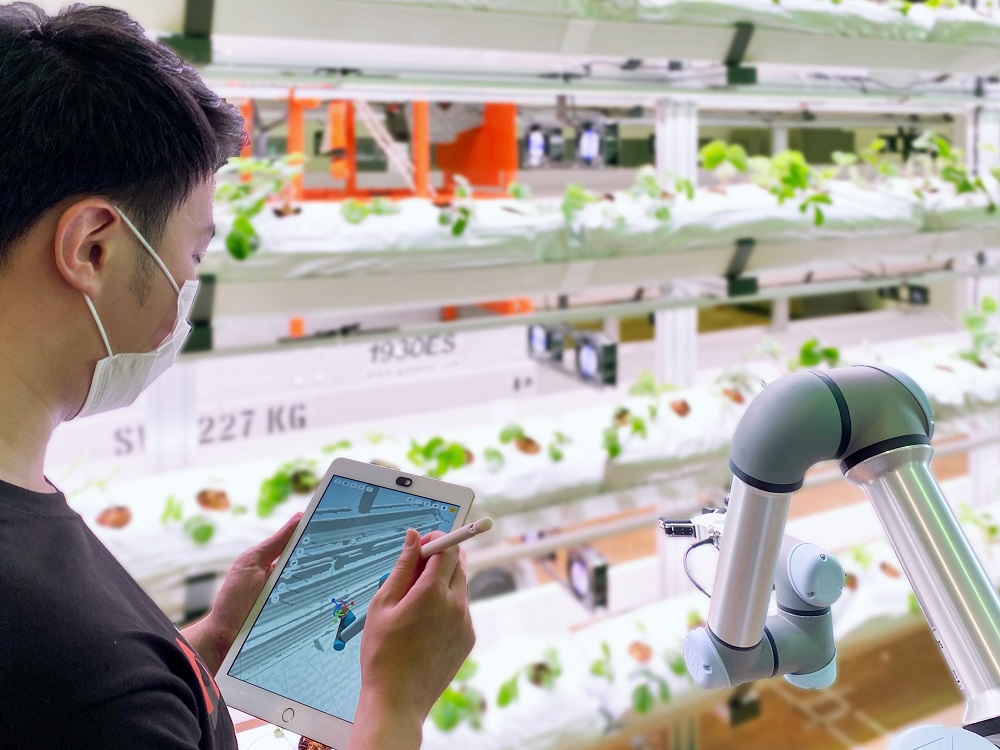COLLABORATIVE robots working as pollinators? To some, that may come as a surprise, but cobots are doing more tasks in the agricultural setting today. With their advanced capabilities, cobots are finding a place in urban farms as well. In this interview, James McKew, the Regional Director of Asia-Pacific in Universal Robots explains how the latest cobots complement the work of urban farmers.

James McKew, the Regional Director of Asia-Pacific in Universal Robots
How are cobots ideal for tasks like harvesting and pollination?
As modern agriculture is becoming digitalised, more automation will be observed in urban farming. The harvesting and pollination processes often require a soft touch to handle the delicate flowers and fruits. However, these processes are a challenge for humans as a high level of concentration and precision are required to conduct such activities. Additionally, urban farmers cannot afford to have such errors which lead to a reduction in output and yield. Hence, collaborative robots or “cobots” have become an ideal solution to automate the harvesting and pollination processes. Unlike the large and bulky traditional industrial robots, cobots are lightweight, versatile and flexible. One of the key features of cobots is its capability to work alongside human workers without safety cages (upon risk assessment), giving manufacturers the best of both humans and robots combined. These cobots can perform tasks effortlessly and repeatedly with a consistent throughput without compromising on quality standards.
How is labour divided between cobot and urban farmer?
All cobots from Universal Robots (UR) are designed to work in close proximity with human workers, addressing safety concerns in the workplace environment. Typically, most urban farmers do not have the luxury to implement robots that require large conventional spaces. Hence, compact cobots are an option for them.
For Singrow, a developer of innovative agri-tech solutions for producing fruits and vegetables, a UR3 cobot was deployed to automate pollination and harvesting in their strawberry farming. The UR3 cobot is a smaller collaborative table-top robot, perfect for light assembly tasks and automated workbench scenarios. UR3 cobot is designed in a compact form and its small footprint makes it a good fit for tight workspaces like the strawberry farm at Singrow. While the cobots take over the repetitive and strenuous tasks, human employees are relieved to work on better and more exciting tasks. Human employees can then move forward to manage more important tasks that require cognitive and social talents.

With the ability to reuse programmes for recurring tasks, cobots support agile processes with minimal set-up time and effort (Photo © Universal Robots)
Can these cobots harvest any fruit or vegetable similar to strawberries?
Cobots are easy-to-use, flexible and can be easily redeployed to multiple operations including the harvesting of other fruits without changing the production layout. With the ability to reuse programmes for recurring tasks, cobots support agile processes with minimal set-up time and effort. Additionally, every production process in different factories or farms are different, making it difficult to create a standard package. There will always be different tasks to customise and in this case, Universal Robots offer the capability of customising through replaceable end-effectors. An end effector is a peripheral device that is attached to a robot's wrist according to the task it needs to perform. Most end effectors are mechanical or electromechanical and serve as grippers, process tools, or sensors. Universal Robots provides a wide variety of end-effectors to suit different tasks through UR+, an ecosystem of third-party end-effector solutions and other add-ons for the cobots. Hence, farmers can take advantage of the versality of cobots, redeploying them to adapt to different circumstances, production requirements and needs.
What are some of the cobot applications in the strawberry farm?
At Singrow, the conventional means of pollination were done by hand instead of bees, which could be prone to human error. As such, Singrow needed a solution to alleviate human errors and improve productivity. They partnered with Universal Robots and Augmentus, a leader in easy-to-use and rapid AI-robotics software, to automate pollination and harvesting in their strawberry farm. Singrow deployed UR3 cobot, adapted with a camera that would identify flowers using Augmentus’ integrated AI technology for effective pollination once the on-board camera identifies the flowers. Additionally, with the use of cameras or infrared scanners, the UR3 cobot is programmed to pick out ripe strawberries.
Is there an ideal ratio to the number of cobots to the size of a farm?
The number of cobots deployed in farms depends on the type and scale of operations based on customers' requirements. For example, Japan-based food and agriculture company, Osaka Nursery implemented a UR10e cobot to automate part of the seedling cultivation process. As the production of seedlings requires substantial manpower, Osaka Nursery needed a solution to take over simpler, manual tasks so that humans can work on more complex responsibilities. Hence, the compact and flexible cobots are perfect for their operations. Since UR cobots can be easily programmed for a wide range of tasks by simply exchanging their end-effectors, Osaka Nursery introduced one cobot in the process of seedling production.
How do you address farmers' concerns when it comes to adopting robotics?
Some farmers may be averse to new technologies such as automation and robots and stay with familiar and more traditional methods for harvesting. Others may have the perception that robots are expensive to purchase, difficult to maintain, inflexible and takes up a significant amount of space. Since consumers often associate cobots with traditional industrial robots, misconceptions on cobots arise.
In fact, today's cobots are versatile and flexible and adaptable to urban farming purposes. These small-sized cobots are not only cost-effective but their easy programming makes them ideal for a wide range of agricultural applications. Farmers need not worry about the unintuitive programming of robots since cobots are easy to implement, operate and maintain.
Does Universal Robots offer after sales service for its cobots/robots?
At Universal Robots, we offer after sales services through our global distribution network. We empower our customers to proactively monitor, optimise and safeguard cobot performance with enhanced support and preventive maintenance through Service360. It is a support offering that enhances performance, increases uptime, mitigate risks and enables success by ensuring customers are prepared for the unexpected.
Besides catering to only customers, UR offers free services to make the advantages of cobots accessible to all. Non-customers are given access to the free online training modules, webinars and video tutorials at the Universal Robots Academy (UR Academy). The UR Academy aims to lower the automation barrier by ensuring core programming skills are available to cobot users regardless of their robotic experiences or backgrounds. This ensures that learners, urban farming aspirants or small and mid-sized enterprises (SMEs) are able to maximise the potential of their cobots.
Are there existing government initiatives for the adoption of automation in the agriculture landscape? What is the update in Asia for this?
In Singapore, the local government has set aside S$60 million for a new Agri-Food Cluster
Transformation Fund (ACT) as part of the Budget 2021 initiatives. Singapore hopes to replace the Agriculture Productivity Fund (APF) in 2020 by assisting the agri-food industry in improving productivity and fulfilling Singapore's goal of producing 30 percent of its nutritional needs through local farms by 2030. The government is actively encouraging farmers to adopt automation for increased production and financial gains.
The Asia Food Challenge reports that the Asia's population will expand another 250 million by 2030. The growing population brings about new challenges in the agricultural and food landscapes. With more mouths to feed, countries who rely heavily on imports need to solve this food challenge. Such government initiatives further aid farmers in the deployment of collaborative automation, ensuring a sustainable future for Asia.
What is Universal Robots' vision of urban farming in APAC/Southeast Asia?
With widespread awareness of global warming and a move towards eco-friendly living, adopting urban farming is a step towards sustainable life and a green future. It minimises carbon footprint of mass production and distribution and even more crucial for non-agricultural nations like Singapore, where food security is a concern and further exacerbated by the COVID-19 pandemic.
Urban farms are often in places where growing food was difficult or nearly impossible in the past, such as indoors, without natural sunlight or within a small space. It is often with the support of agri-technology that urban farms can thrive.
Cobots have been deployed in food & beverage manufacturing extensively in recent years due to their flexibility, cost-efficiency and small footprint and with urban farming becoming increasingly part of the food supply chain, more cobots are expected to be utilised to improve productivity and yield in urban farms, too.
How will robotics improve urban farming?
Urban farmers face constraint spaces, a lack of skilled manpower, and some of the processes which happen in nature have to be done manually because of indoor environments.
For example, some urban farms are indoors without natural lighting, so pollination by bees are not possible, and manual pollination is required. Due to the vast number of flowers to pollinate, this repetitive yet delicate task would be prone to human errors. Hence, cobots are introduced to urban farming to automate the pollination process, alleviating human errors and improving productivity. With the implementation of cobots in urban farming, the delivery of the freshest and best quality produce grown locally in Singapore is now a reality.
Another example would be Osaka Nursery, which needed skilled workers for seedling cultivation, but an ageing population makes it difficult to secure labour. In order to maintain consistent production outputs, Osaka Nursery deployed a cobot to automate these repetitive tasks, and skilled workers are freed up to manage more complex tasks.
Designed to work alongside humans, cobots are safe enough to function around people and do not require the same kinds of safety infrastructure industrial robots do (upon risk assessment). Moreover, UR cobots can be easily programmed for a wide range of tasks by simply exchanging their end-effectors, hence Osaka Nursery only need to introduce one cobot in the process of seedling production.














